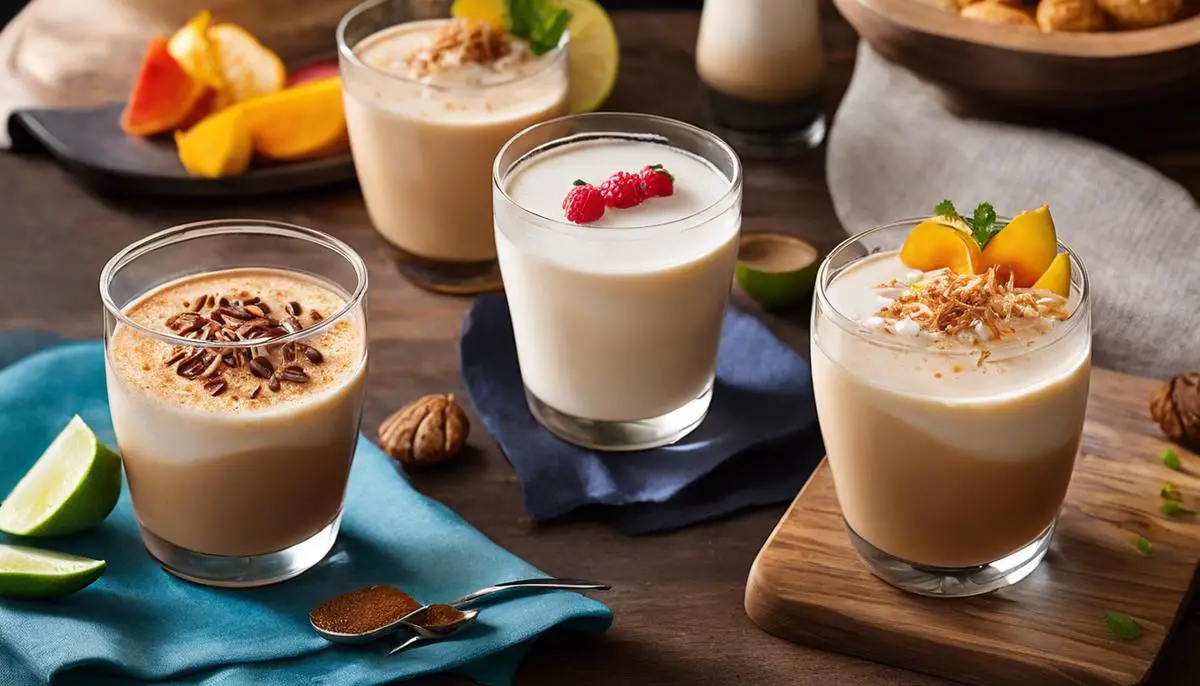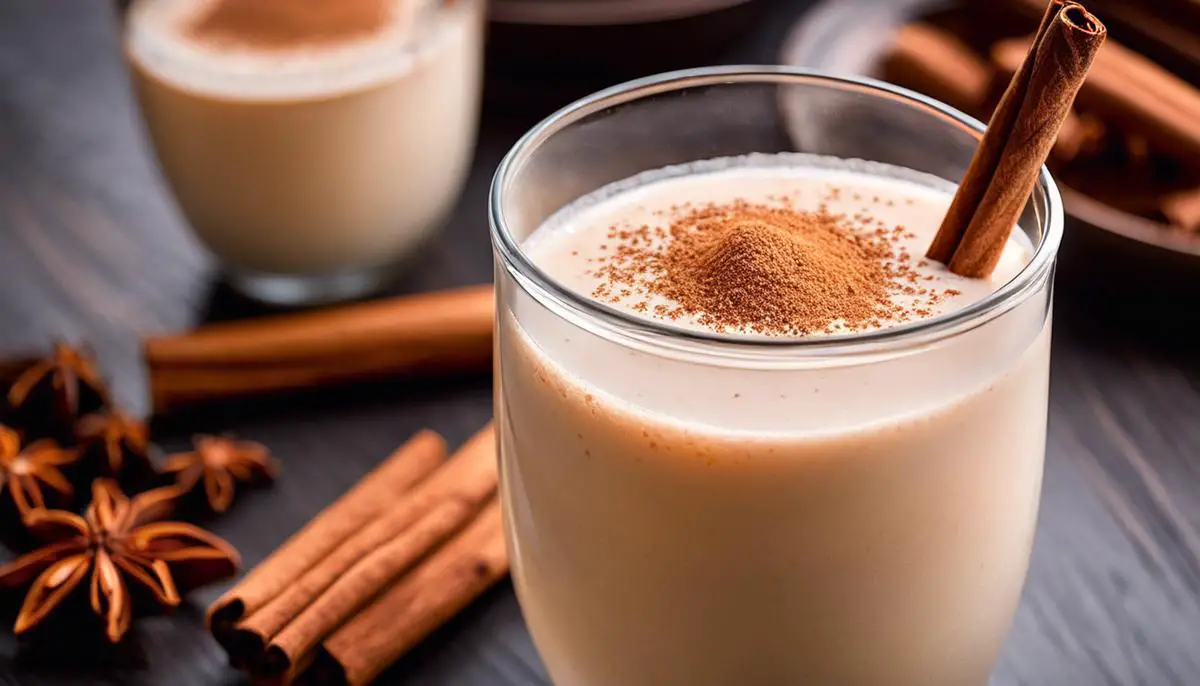
Imagine a drink that’s as captivating as a historical novel, one that has traversed continents, adopted forms dictated by diverse cultures, and yet retained its inherent character. That’s horchata for you. From Valencia in Spain to the streets of Mexico and Los Angeles, from the humble homes of West Africa to the high-end restaurants in Manhattan, horchata has made quite the journey. A traditional beverage known for its refreshing coolness and sweet, nutty taste, horchata – at its core – remains a simple, satisfying concoction. But delve deeper and you will unravel the depths of versatility, not just in its ingredients and preparations but also in its role within global cuisines.
Origins of Horchata
Originating from the scorching sun-blazed lands of ancient Valencia, Spain, horchata is a delightful beverage that spins an intriguing tale of a journey from antiquity to modernity.
Traditionally made from tigernuts, a plant native to the Mediterranean region, the initial form of horchata was known as “Hordeum Vulgare,” consumed for its thirst-quenching and nutritional properties. Spanish explorers introduced this refreshing drink to the Americas, where in lieu of tigernuts, various ingredients such as rice, cinnamon, and sometimes vanilla began to be used, marking the evolution of the earthly beverage into a delectable sweet treat.
With each region it traveled to, horchata adapted itself, absorbing local flavors, and yet managing to retain its distinctive character. In Mexico, for instance, the drink is typically a deliciously sweet blend of rice, cinnamon, and sugar, served chilled. Evolving further west, in the United States, horchata has even been incorporated into desserts and ingenious alcohol mixtures, paying homage to its malleability and expansive influence.
Long removed from its original rendition, today’s horchata serves as a testament to centuries of gastronomical transformations and cultural fusion. So the next time you happen to indulge in the icy cool richness of a glass of horchata, take a moment to appreciate this drink’s remarkable journey from its humble beginnings in Valencia to liquid decadence in your glass.

The Traditional Recipe and Variations of Horchata
Delving into the core foundation of horchata, the authentic recipe mainly revolves around chufa, or tigernuts. These nuggets are soaked in water, ground into a rich pulp, and then strained to yield the iconic refreshing drink. Widening the culinary lens, variations are found where rice replaces tigernuts due to regional availability. In this textural symphony, the soaking rice dances with almonds, a sprinkle of cinnamon and a blush of vanilla to create an intriguing twist, then sweetened with sugarcane.
With a daring spirit of culinary exploration, horchata seamlessly crosses borders, nestling into the food culture of different regions with a chameleon-like easiness. In Mexico, for example, it takes on a silky texture with the inclusion of rice and often sports an aromatic note of cinnamon. Head further south, and in Guatemala & El Salvador, one finds jicaro seeds and calabash gourds playing a starring role instead. Venture off to the North, and in the United States, horchata caters to the local palate blending rice milk and almond milk, often spiked with a dash of rum or served atop an espresso for a creamy caffeinated kick.
The diversity of horchata reflects its incredible adaptability, metaphorically painting a global gastronomic picture that screams celebration of multi-culturalism within every sip. So, whether it’s a warm evening in Spain, a bustling street in Mexico, or a chic café in California, horchata stands as a testament to culinary invention and adaption, binding foodies around the globe over this fabulous shared experience.

Health Benefits and Nutritional Value of Horchata
Horchata’s potent nutritional canvas is mostly attributed to its key ingredient–the tigernut (also known as chufa). This small but mighty tuber, cherished for centuries in Valencia, is bursting with an array of nutrients that make horchata much more than just a refreshing drink. Tigernuts, whether used whole or, more commonly, in its ground form, serve as a potent source of fiber, helping to boost digestion and impart feelings of fullness. It’s a superior pick-me-up on sweltering afternoons when hunger pangs hit the hardest.
Moreover, horchata offers an array of valuable vitamins and minerals. Tigernuts are rich in iron and potassium, enhancing the drink’s nutritional profile. Plus, here’s a buoyant tidbit for those with a sweet tooth: traditional horchata is typically sweetened with cane sugar, but healthier alternatives like agave or honey could be used instead, making it a guiltless indulgence with a lower glycemic index. Also, due to its dairy-free nature, horchata is an excellent choice for lactose-intolerant and vegan food enthusiasts. The flexibility in natural sweeteners and rich, milky texture makes horchata a universally beloved beverage.
In terms of health benefits, horchata’s impressive fiber content is a significant contribution to maintaining a healthy gut. It aids digestion and promotes feelings of satiety, which can be beneficial for those aiming for weight management. Furthermore, the magnesium found in tigernuts serves as an excellent muscle relaxant, reducing cramps and tension in the body. Above all, horchata—with its warming blend of cinnamon and delicate sweetness— soothes the soul, lifting morale and fighting stress. Be it sipped on a picturesque terrace in Valencia or enjoyed at a bustling food truck in Los Angeles, the comforts offered by this simple, humble drink are universal.

Horchata Pairings and Uses in Modern Cuisines
Outside of its classic role served chilled in a tall glass on a hot day, horchata’s unique flavor profile has acquired a thrilling platform in varied culinary exploits recently.
Adventurous chefs and food enthusiasts, captivated by its sweet and comforting nuances, have tapped into its potential and breathed fresh life into their dishes with a horchata twist.
Horchata now finds itself in a spectacular array of dishes, from a surprising splash in creamy risottos, lending a delicate sweetness and depth to the dish, to Spanish-style flan, where it offers a subtle, nutty back note.
Even a traditional cinnamon roll doesn’t escape horchata’s charm. Glazes made with horchata instead of milk add a sprinkle of indulgence, revealing intriguingly delicious layers beneath the already staple dessert.
For that matter, think of horchata ice cream – an association so seamless, it leaves one wondering how it took so long to be discovered!
In terms of pairing, horchata exhibits a unique camaraderie with spicy foods. The creaminess of horchata, especially those of Mexican versions that are often made with rice or almonds, beautifully tames the heat of spicy dishes.
Think tacos al pastor or fiery Thai noodles; horchata stands as a soothing contrast to balance the spice level. Moreover, its harmonization with cinnamon suggests a divine pairing with sweet treats like churros or cinnamon-infused pastries, imparting a satisfying end note to a meal, where each flavor complements the other.
With its robust offerings and remarkable adaptability, horchata is proving to be a unique bridge connecting traditional palate with modern cuisine, as it continues to inspire mouthwatering recipes and unique food pairings. Bon Appétit!

Home Brew: Making Horchata at Home
Creating an authentic taste of horchata at home can transport one’s palate back to its humble roots in the vibrant streets of Valencia, but it’s not as difficult as it may seem.
Since the availability of tigernuts can be scarce in some parts of the world, a common way to emulate its flavor is by using long-grain white rice.
Soak the rice overnight, allowing the grains to soften and absorb the water, which is a vital step in achieving that silky texture.
Rice may not be the original base, but its blandness allows the other ingredients to shine, contributing to a surprisingly rich and complex flavor.
To enhance that richness, hot water is essential during the soaking process as it facilitates the extraction of starch from the rice.
This will give horchata its distinctive milky appearance.
A combination of vanilla and cinnamon is used to replicate the natural sweetness and nuttiness of tigernuts.
Adding sugar at the end while it’s still warm ensures that it dissolves completely, providing a smooth and satisfying sweetness.
Authenticity also lies in the straining process.
Tradition dictates the use of a cheesecloth to vigorously strain the mixture, extracting as much of the liquid as possible, while leaving behind the gritty residue.
This process may be laborious, but the end result is a clear, creamy, and refreshing horchata that is almost divine.
Making horchata at home is more than just replicating a drink.
It’s about embracing cultural intricacies and experiencing the joy of crafting something with passion.
It’s an opportunity to broaden one’s culinary skills while getting a glimpse into the history and transformation of the humble horchata, a beloved beverage shared and enjoyed around the world.
By mastering these steps, one can derive immense pleasure in savouring a homemade version of this universally loved drink and sharing this culinary delight with friends and loved ones.

Beyond the pleasurable sip of its sweet, refreshing taste, horchata springs surprises with its numerous avatars from cocktails to desserts, proving its versatility and adaptability. As it continues to weave its magic in kitchens around the globe, it also equips you with the gratification of being a home brewer, where you can personalize your recipe to suit your taste and health preferences. As a drink that’s steep in history and robust in taste, horchata is much more than a beverage. It is a bond uniting cultures, nourishing bodies, and creating culinary wonders.



